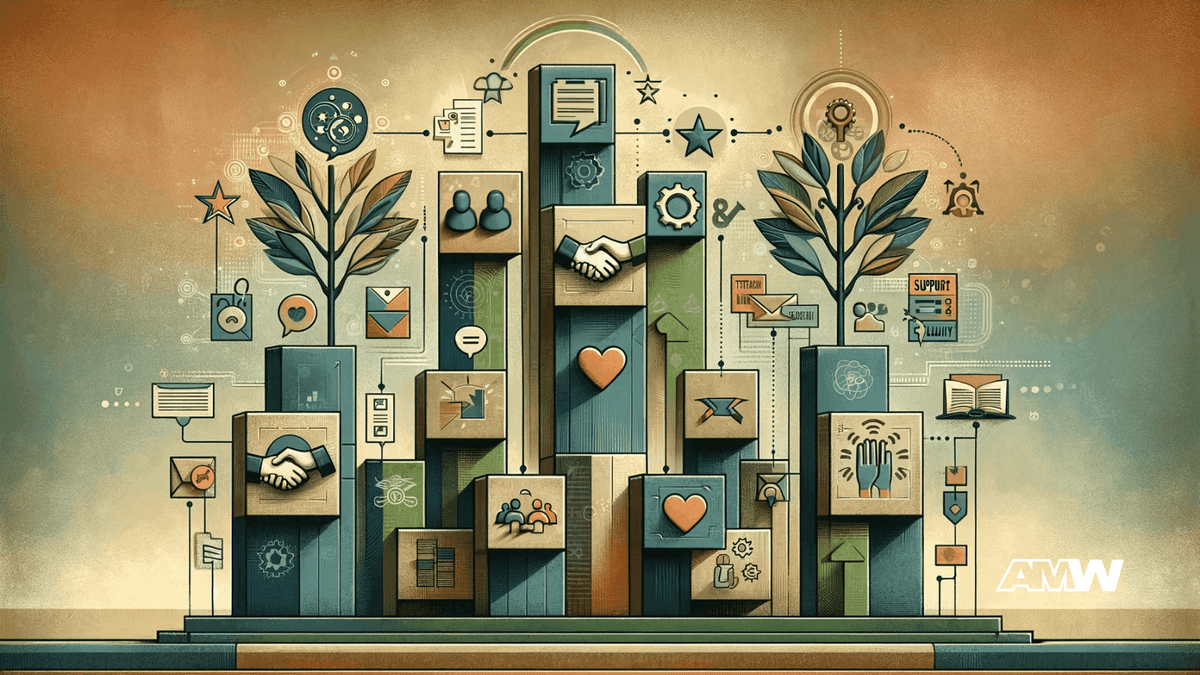How to Create a Customer Success Plan: Strategies and a Template

The concept of a customer success plan has emerged as a beacon of growth and sustainability. But what exactly is a customer success plan?
Quick Summary
A customer success plan is a strategic approach designed to foster long-term relationships between organizations and clients. It involves understanding customer goals and health, monitoring satisfaction, and ensuring retention and loyalty. A successful plan is tailored, proactive, and adaptable, integrating regular feedback and collaboration among teams. By aligning objectives, defining key success metrics, and creating a detailed customer journey map, organizations can drive growth and establis
Simply put, it's a strategic blueprint designed by a customer success team to ensure the long-term success of their clients. This plan goes beyond traditional sales and support; it's about fostering a deep, ongoing relationship that benefits both your customer and your organization.
The importance of a robust customer success plan cannot be overstated. In today's competitive landscape, the role of the customer success team extends far beyond mere customer service. It's about building customer loyalty, ensuring customer retention, and creating customer and product advocates.
Ready to Grow Your Business?
Get a free consultation and custom strategy tailored to your goals.
A well-crafted customer success plan lays the groundwork for achieving these goals, ultimately leading to sustained business growth and a thriving customer base.
The Foundation of Customer Success Planning

Exploring the Definition and Key Components of a Customer Success Plan
A customer success plan is not a one-size-fits-all solution; it's a tailored approach that addresses the unique needs and goals of each customer. The plan is often spearheaded by a dedicated customer success manager or team, who work closely with customers to understand their journey, from onboarding through the entire customer lifecycle.
Key components of a successful plan include understanding customer goals, monitoring customer health scores, and aligning with the customer's expectations and desired outcomes.
The Three Pillars of Customer Success

At the heart of customer success planning are three pillars: customer satisfaction, customer loyalty, and customer retention. These pillars represent the core objectives that every customer success team strives to achieve.
By focusing on these areas, customer success managers and their teams can ensure that they are consistently meeting and exceeding customers' expectations.
What Does a Good Customer Success Plan Look Like?
A good customer success plan is a comprehensive roadmap that guides both your team and your customer towards mutual success. It includes a detailed customer journey map, clearly defined success metrics, and a strategy for regularly reviewing and updating these elements. The plan should be dynamic, adapting to the evolving needs of the customer and the market.
Effective customer success plans are not just about reacting to customer inquiries or issues. They are proactive, leveraging customer data and insights to anticipate needs and create opportunities for growth. These plans require close collaboration across teams, such as sales, marketing, and support, to ensure everyone works towards the same goals.
In summary, creating a customer success plan is a vital strategy for any organization looking to thrive in the modern business landscape. Understanding customer needs, aligning with them, and continuous improvement are key. Having a well-executed customer success plan can exceed customer expectations, driving long-term success and fostering loyalty.
Step-by-Step Guide to Creating Your Customer Success Plan

How to Create a Customer Success Plan: A Step-by-Step Approach
Creating a customer success plan is not just a task; it's a journey towards building a sustainable and rewarding relationship with your customers. Begin by gathering your customer success team and setting clear objectives. A successful plan is more than a document; it's a commitment to your customers' success.
First, assemble all necessary customer data and insights. This is where your customer success managers play a pivotal role. They should understand the customer journey inside out, from the initial sales process to ongoing engagement. This knowledge forms the bedrock of your plan.
Identifying and Prioritizing Customer Needs: The Top 3-5 Priorities
The next crucial step is to identify and prioritize your customers' needs. This isn't about guessing but about engaging in meaningful dialogue with your customers. Conduct quarterly business reviews or surveys to gather customer feedback. Remember, the customer's expectations set the direction for your plan.
Typically, the top priorities include customer satisfaction, product adoption, and customer retention. Align your team's efforts towards these goals. Ensure every member of the customer success team understands these priorities and how their role contributes to achieving them.
Structuring Customer Success Team: Key Elements and Strategies

Structuring your customer success team is about more than roles and responsibilities; it's about creating a synergy that aligns with your customer success strategy. Effective customer success plans incorporate key performance indicators (KPIs) to measure success and customer health scores to gauge ongoing customer relationships.
Develop a customer journey map that details every stage of the customer lifecycle. This map should be the guiding light for your team, ensuring that every interaction with the customer is purposeful and aligned with the overall success plan.
Writing a Success Plan: What to Include and Why

When it comes to writing your customer success plan, clarity and comprehensiveness are key. Your plan should include:
- Customer Goals and Outcomes: Outline what success looks like for your customer. Align these goals with your team's actions.
- Success Metrics and KPIs: Define clear metrics to measure progress. These could include customer retention rates, customer health scores, or Net Promoter Scores (NPS).
- Customer Journey Map: This should detail each touchpoint with the customer, from onboarding to advocacy.
- Action Plan for Each Stage: Develop specific strategies for different stages of the customer lifecycle, like onboarding, product training, and support.
- Feedback and Adjustment Mechanism: It is important to regularly collect and address customer feedback so that your team can continually improve and adapt the plan.
- Expansion Strategy: Plan for future growth with the customer, including upselling and cross-selling opportunities.
Remember, a customer success plan is not static. It should evolve with your customer's needs and your team's learning. It is important to review and update the plan on a regular basis to ensure that it stays relevant and effective. Make sure to check it frequently to make necessary changes and improvements.
In conclusion, developing a customer success plan is crucial for ensuring customer satisfaction and longevity. It's about putting your customers at the heart of your business and aligning your team's efforts with their success. With a clear, actionable, and adaptive customer success plan, you're not just aiming for customer satisfaction; you're striving for customer delight and loyalty.
Essential Strategies for Effective Customer Success Plans

The Role of Client Success Planning in Business Growth
In business growth, client success planning is not just an option; it's a necessity. A well-crafted customer success plan is a testament to your commitment to your customers' achievements and your own. It's about creating a partnership where both your customer and your business grow together.
This synergy is achieved when the customer success team focuses on aligning customer goals with your business objectives. A customer's success should be seen as a cornerstone of your company's growth strategy.
Every successful interaction, every resolved inquiry, and every piece of customer feedback brings invaluable insights that can drive innovation and improvement.
Building a Strong Customer Success Strategy

Creating a successful customer experience requires a comprehensive approach that covers the entire customer journey, rather than just addressing customer inquiries. This strategy should be crafted by customer success managers and their teams, focusing on customer satisfaction, retention, and loyalty.
It's important to have a clear understanding of the customer journey, defined success metrics, and their expectations and pain points.
Your strategy should include plans for regular customer contact, such as quarterly business reviews, to ensure that you're consistently aligned with customer needs and can demonstrate progress.
The 4 Models of Succession Planning in Customer Success
Succession planning in customer success is crucial for maintaining continuity and service excellence. There are four main models to consider:
- The Hierarchical Model: Focusing on developing leaders within the customer success team for future roles.
- The Specialization Model: Encouraging team members to specialize in specific areas of customer success.
- The Rotation Model: Offering team members the chance to work in different roles within the team, fostering a more holistic understanding of customer success.
- The Mentoring Model: Pairing less experienced team members with seasoned customer success managers for guidance and knowledge transfer.
Ready to Grow Your Business?
Get a free consultation and custom strategy tailored to your goals.
Each of these models plays a vital role in ensuring that your customer success team remains robust, versatile, and ready to face future challenges.
Developing and Implementing an Account Success Plan
An account success plan is your blueprint for individual customer engagement. It's about understanding the unique needs and goals of each customer and how your product or service fits into their success story. This plan should be tailored to each customer, taking into account their customer data, feedback, and health score. It is crucial to establish precise key performance indicators (KPIs) and success metrics that are regularly evaluated. This will help in better understanding the progress being made towards achieving the desired goals and objectives.
Close collaboration between customer success, sales, and marketing teams is essential in developing an account success plan. This ensures a unified approach and helps in aligning the expectations of all stakeholders involved. The goal is to create processes that not only address feedback but also proactively identify opportunities for customer expansion and success.
In order to ensure effective customer success, it is necessary to establish and maintain a strong and mutually beneficial relationship with your customers. It's about being proactive, responsive, and constantly evolving to meet and exceed customer expectations. By focusing on these essential strategies, you're not just working towards reducing customer churn; you're building a foundation for lasting customer loyalty and continuous business growth.
Remember, in customer success, every small step taken is a leap towards achieving monumental success for both your customers and your business.
Templates and Tools for Crafting Your Plan

Customer Success Plan Templates: A Practical Resource
Embarking on the creation of a customer success plan can feel daunting. However, with the right templates at your disposal, this journey becomes more navigable and efficient.
Customer success plan templates serve as a valuable resource, providing a structured framework to build upon. These templates include key sections like customer goals, strategies for onboarding new customers, customer health score tracking, and quarterly business reviews. They guide customer success teams to cover all necessary aspects, ensuring that no critical element is overlooked.
Remember, these templates are not set in stone but are starting points to be tailored to each customer's unique journey.
Template example
Now, let's dive into a practical example of what a customer success plan template might look like. Remember, this template is a starting point, a framework to build upon and customize according to the unique needs of your customers and your business. A well-designed customer success plan template is a powerful tool in your arsenal, guiding you towards achieving success for your customers and your company.
1. Customer Overview
- Customer Name:
- Business Sponsor:
- Key Stakeholders:
- Customer Goals:
2. Customer Onboarding
- Onboarding Process:
- Key Milestones:
- Assigned Customer Success Manager:
3. Quarterly Business Review Plan
- Review Dates:
- Objectives:
- Success Metrics:
4. Sales Process and New Customer Acquisition
- Sales to Success Transition:
- New Customer Welcome Strategy:
5. Customer Health Score Monitoring
- Key Metrics for Health Score:
- Regular Monitoring Schedule:
Ready to Grow Your Business?
Get a free consultation and custom strategy tailored to your goals.
- Action Plan for Health Score Improvement:
6. Customer Experience and Engagement
- Regular Check-ins Schedule:
- Customer Feedback Mechanisms:
- Customer Advocacy Opportunities:
7. Expansion and Renewal Strategy
- Up-sell/Cross-sell Opportunities:
- Renewal Milestones and Strategy:
8. Notes and Observations
- Customer Feedback Highlights:
- Team Observations and Insights:
This customer success plan template serves as a roadmap to guide you and your customer through the journey of collaboration and growth. It ensures that you stay organized, aligned with customer expectations, and deliver an exceptional experience. From the initial onboarding process to regular quarterly business reviews, this template empowers you to create customer success plans that are both effective and dynamic.
Remember, the key to a successful customer success plan lies in its adaptability and alignment with your customer's evolving needs. Use this template as a foundation to build upon, tailoring it to fit the unique circumstances and goals of each customer.
With this approach, you're not just creating a plan; you're forging a path to help your customers achieve their goals, nurturing a relationship that leads to mutual growth and success.
Tools and Software for Organizing and Implementing Your Plan
Leveraging the right tools and software is crucial for implementing an effective customer success plan. These tools help organize customer data, track key metrics, monitor customer health scores, and facilitate communication within the team and with customers. They enable customer success teams to stay on the same page, align expectations, and reduce churn effectively.
Utilize software that integrates with your sales process, allowing for a seamless transition of customer contact information and insights from the sales teams to the customer success team.
How to Stay Organized as a Customer Success Manager
Being an effective customer success manager requires a key skill of staying organized. It involves not just managing customer notes and feedback but also aligning with the broader customer success strategy and team goals. Regularly update and review customer outcomes, confirm expectations, and create processes to address feedback.
Organizing quarterly business reviews with customers is also vital to demonstrate progress, reassess goals, and align strategies for continued success.
Conclusion

Summarizing the Importance of a Well-Structured Customer Success Plan
As we conclude, let's reemphasize the pivotal role of a well-structured customer success plan. It's more than a document; it's the backbone of a thriving business, a strategic blueprint that guides customer success teams in nurturing and sustaining productive relationships with customers. This plan is crucial in ensuring your customers' success, which in turn, becomes your success.
It meticulously addresses every facet of the customer's journey, from onboarding to ongoing engagement, and anticipates their evolving needs, paving the way for effective product adoption and fostering customer advocacy.
A good customer success plan, exemplified by a comprehensive customer success plan template, does not leave customer satisfaction to chance. It strategically maps out the sales process, ensures smooth onboarding of new customers, and creates customer success plans that are tailored to meet specific needs.
This approach results in a dynamic interaction where customers don't just feel heard, but genuinely understood.
Encouraging Continuous Improvement and Adaptation in Customer Success Strategies

In customer relations, continuous improvement and adaptation are not just beneficial; they are imperative. Your customer success plan must be a living document, one that evolves with customer feedback, shifts in market trends, and fresh customer insights.
Regularly engaging in quarterly business reviews offers a platform to reassess and realign strategies with your customer's expectations and goals.
It is essential to foster a culture where every member of the customer success team, from the frontline managers to the business sponsors, is committed to this ethos of continuous improvement. Create and update customer success plans regularly to track progress and identify areas for improvement.
Encourage your team to stay proactive, not just in managing current customer relationships but also in anticipating future needs and opportunities.
In essence, a successful customer success plan is a collaborative effort that requires the involvement and commitment of the entire team. From the initial stages of creating a customer success plan to the continuous process of adapting and improving it, every step is crucial. It's about aligning your team around a shared vision of customer success, where the success of your customers equates to the success of your business.
In conclusion, as you embark on this journey of creating and refining your customer success plans, remember that at the core of every strategy, every decision, and every action is your customer. Your dedication to their success is what will ultimately drive your business forward.
Here's to building robust, lasting relationships, achieving remarkable outcomes together, and celebrating each milestone of success along the way!

Ready to Grow Your Business?
Get a free consultation and custom strategy tailored to your goals.